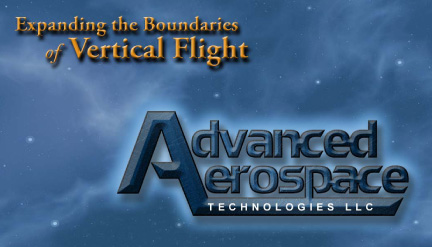.pdf)

EXECUTIVE SUMMARY
Background Discussion: In 2011 the US Department of Defense issued “The Future Vertical Lift Initiative: A Strategic Plan for United States Department of Defense Vertical Lift Aircraft” and with this release the quest for next-generation vertically lift capabilities was formalized. In part, the DoD’s goals for “Future Vertical Lift (FVL)” were driven by assessing the maturity of both existing and emerging technologies from within their established OEM supplier base as well as identifying key non-traditional, high-tech startups. In addition to the military requirements, the commercial market drivers for advanced vertical lift, including heavy logistics, search and rescue, and general aviation, prompted many aerospace companies to conduct Independent Research and Development projects focused on commercializing generational-leap technologies.
One successful company, Advanced Aerospace Technologies, was awarded two landmark US patents, 7,147,182 and 7,275,711, for VTOL aircraft designs utilizing reaction driven rotor technologies. These design patents termed “Tiltrotor” and “Compound” aircraft respectively, were inspired by an innovative concept called “thrust augmentation” hypothesized by Professor J.V Foa, Professor of Aeronautical Engineering at Rensselaer Polytechnic Institute. Professor Foa contended the thrust of the aircraft could be increased without an increase of energy input by placing “reaction drives” at the rotor tips. By utilizing these reaction drives, new VTOL designs can now eliminate the heavy, expensive, high maintenance transmissions, drive shafts, clutches, and backup systems making the aircraft more efficient, more effective, and with lower total ownership costs and ease of operation. The primary difference between the two designs is the Compound aircraft only uses the rotor for takeoffs and landings whereas Tiltrotor the rotors are required for forward flight.
Highlights and Accomplishments: Both designs have been through a rigorous and independent Preliminary Design Review by AirBoss Aerospace, an aeronautical engineering firm, contracted by the company. Furthermore, a quarter-scale model of the rotor assembly was built and tested by the company with remarkable results. Our computer analysis of the 2150 Kg Compound aircraft could cruise at 325 knots at FL250, while the 3475 Kg Tiltrotor is expected reach 400 knots at the same altitude. Finally, Advanced Aerospace Technologies was honored to collaborate with the Georgia Tech Aerospace Department in evaluating reaction versus conventional drives as part of their participation in the annual International Rotorcraft Design Competition sponsored by the American Helicopter Society in 2013.
Current Market Assessment: Multiple strategic aerospace companies including Textron-Bell, Lockheed, Boeing, and Sikorsky along with venture startups AVX, Carter Aviation Technologies have been highly active in positioning within the $115B FVL market with Textron eventually purchasing exclusive rights to Carter technologies.
The Opportunity: Advanced Aerospace Technologies is actively soliciting and evaluating proposals from strategic-OEM companies looking to acquire exclusive rights to our patents to develop, design and commercialize these technologies for both commercial and military FVL applications.